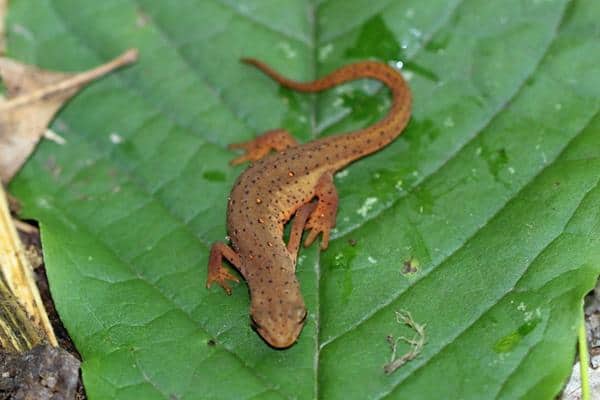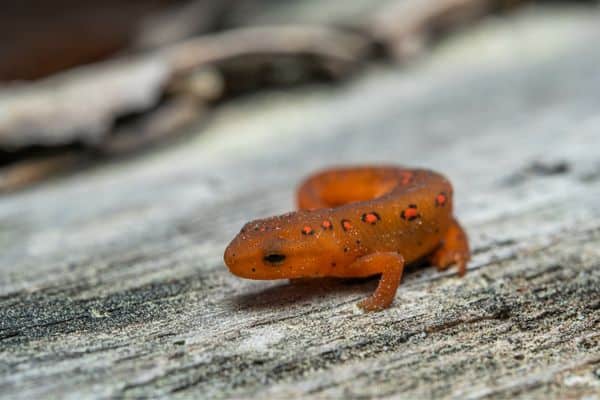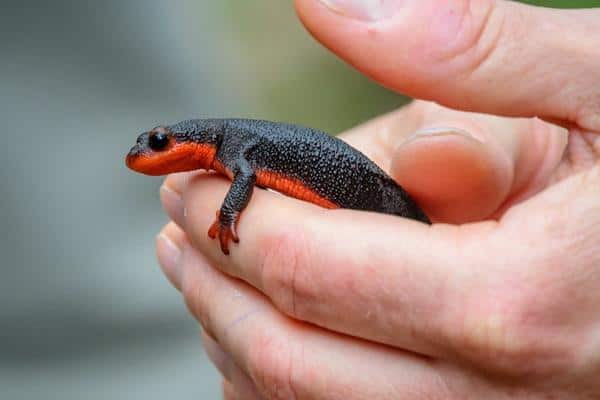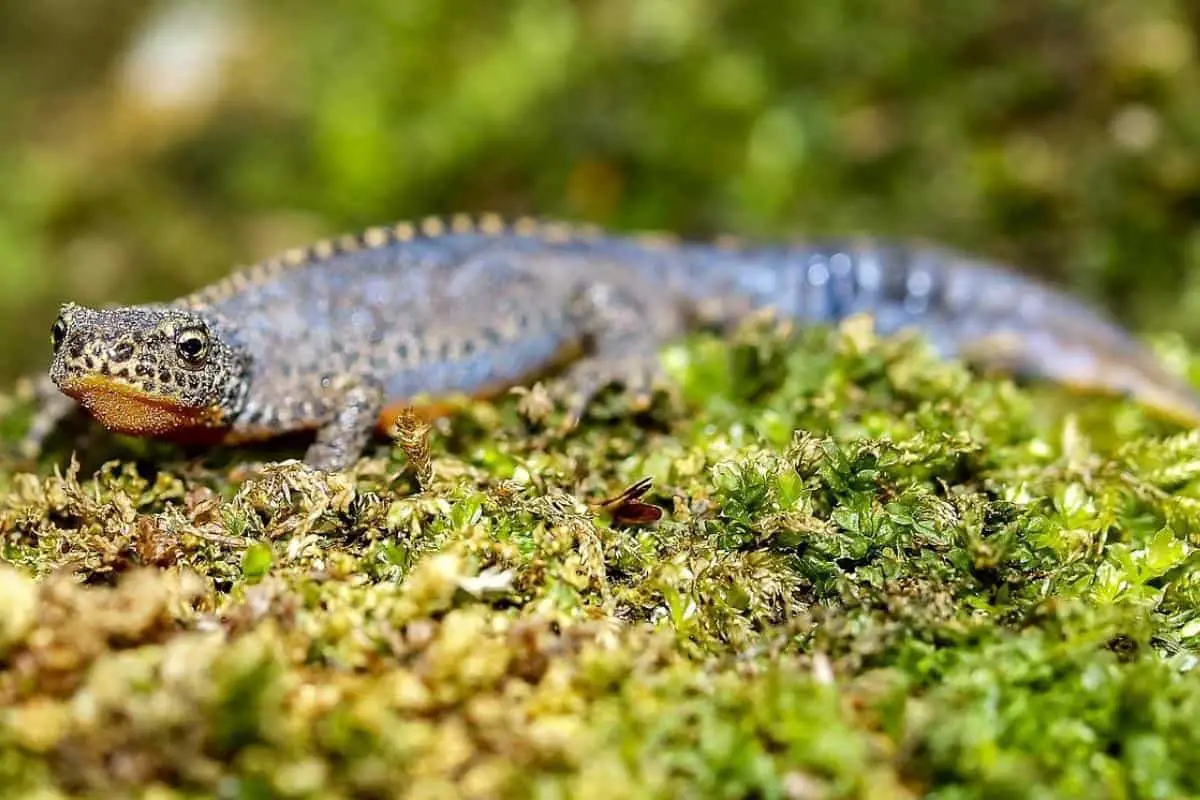There are many different types of salamanders and newts in North America. Often dry-skinned; newts are a type of salamander that resemble a combination of both a frog and lizard, but they are neither. With skin glands that can ooze poisonous toxins; these creatures defy the regular habits of other amphibians.
North America’s newts are able to regenerate body parts, breathe with lungs, change their appearance, and survive completely on land. Born in the water, young newts transform into efts before setting off on their epic migration to find new lives in a distant land.
Newts in North America
Living in water and walking on land, these creatures have become successful homesteaders in many North American regions. Here are 10 different types of newts in North America.
1. The Black-spotted Newt

Scientific name: Notophthalmus meridionalis
States found:
- Texas
- Alabama
Endangered, the Black-spotted newt has a bold mustard-colored underbelly with the same bold color spots everywhere else. Borrowing the burrows of invertebrates, these amphibians make sure a predator knows just how dangerous it is to be eaten. Flashing its bright belly, predators are well warned that having this salamander for lunch will be their very last meal.
2. Striped Newt

Scientific name: Notophthalmus perstriatus
States found:
- Georgia
- Florida
- South Carolina
Recently added to the conservation lists, these little guys can be seen with bright red stripes on each side of their bodies. This type of newt has been found to have adults with either gills or lungs. Reproduction is achieved by male spermatophore (deposits on the ground) activity and female collection of the deposits to use for internal fertilization.
3. Red Spotted Newt

Scientific name: Notophthalmus viridescens
The red-spotted newt can be found in the following states:
- New York
- New Jersey
- Connecticut
- Maryland
- Pennsylvania
- Delaware
- Massachusetts
- Vermont
- Rhode Island
- Indiana
- New Hampshire
- Maine
- Illinois
- Tennessee
- Michigan
- Kansas
- North Carolina
- Virginia
- Alabama
- Ohio
Having conquered the eastern portion of North America, the Red-spotted newt is the most prolific and largest distributed newt in the states. The life cycle of this particular newt is also larger as it takes an additional fourth developmental cycle to fully develop into maturity.
Mothers will lay up to 400 eggs at one time, and each little larva develops into either a terrestrial(land) or aquatic (water) specific newt. Once the eft (teenage metamorphosis) takes place the creatures will walk almost 500 feet in a single day.
4. Central Newt

Scientific name: N. v. louisianensis
Central newts can be found in the following states:
- Arkansas
- Indiana
- Illinois
- Iowa
- Louisiana
- Missouri
- Oklahoma
- Wisconsin
This particular newt grows into a fiery orange belly and a pair of lungs. This newt may not always sport black polka dots on its body but is always found with dark racing stripes over its eyes.
This particular newt (born fully aquatic) lives up to two years on land as an eft (teenager) before it returns to the water to turn into an adult. Once this newt makes its final transformation, it will live the remainder of its life right back beside the water.
5. Broken Striped Newt

Scientific name: N. v. dorsalis
States found:
- North Carolina
- South Carolina
The smaller of all the newts on our list, Broken striped newts grow up with bright red dashes rather than the same dots and racing stripes as all of the others. The broken striped newt has a neotenic (delayed metamorphosis) rate compared to that of other newt species.
6. Peninsula Newt

Scientific name: Notophthalmus viridescens piaropicola
States found:
- Florida
- Kansas
- Texas
- Minnesota
The Peninsular newt is a dark green, often black speckled newt with a very deep amber underside. They remain beside water no matter what stage of life they are in.
Water vegetation is used heavily by these newts serving as both a walkway and a place to reproduce. Newts in this species tend to inhabit waterways created by farming practices as well as by waterways inhabited by beavers.
7. Rough Skinned Newt

Scientific name: Taricha granulosa
States found:
- Alaska
- California
- Idaho
- Montana
- Oregon
- Washington State
Voted the Most poisonous newt in the state of Washington, these little creatures love to show off their blazing bright bellies to anyone who dares look at them as a tasty treat.
The rough-skinned newt has a muddy-colored avocado-style back while the venter(underbelly) is either a brilliant shade of yellow, orange, or red.
Females of this species take their time and lay each egg individually onto pieces of underwater substrate. Rough-skinned newts are neotenic (larva reproducing larva) increasing their ability to maintain the diversity in their DNA at the expense of a shorter lifespan.
8. Red-Bellied Newt

Scientific name: Taricha rivularis
State found:
- California
Born into the water just like all the others, the red-bellied newt grows up by going underground. When reaching adulthood, the newt migrates into underground burrows where it will live for up to six years before looking for love. This particular newt has aged, or lack thereof aced as the lifespan of a red belly can easily reach thirty years.
9. California Newt

Scientific name: Taricha torosa
State found:
- California
Similar to the rough-skinned newt in colorization, the California newt can be identified by a small dash of belly colorization underneath its eyes. The eye color is also distinct in that the pigment is darker in comparison with other North American Newts. Not unlike some salmon, this newt returns to the same water in which it was born.
A male of this species must court a female by engaging in dancing and chin rubbing. Females also gather fertilized substrate to impregnate the 30 eggs she holds onto internally. Skin toxicity is also prevalent in this species with the poison equivalent to that of the pufferfish or harlequin frogs. This species is endemic to California.
10. Sierra Newt

Scientific name: Taricha sierrae
State(s) found:
- Nevada
- California
The Sierra newt is predominantly a land-dwelling species. With its preference for cool wet winters and warm drier summers, this species thrives inside a Mediterranean climate that can be found in areas like the Sierra Nevada.
This newt is especially warty in appearance and the teeth are fixed in a fang-style pattern (vomerine) that resembles the letter Y. The yellow eyes of this species are both big and bright, protruding outward from the body more so than other species.
Female egg fertilization is aided by amplexus ( males using the foot and toe pads) in courtship to hold onto females. Males have to compete to win a female’s favor and often females will cannibalize the eggs if they are found around them.
The juvenile stage of this newt lasts the longest at eight years and newt communication is high in this species, utilizing clicks, tail wagging, and an occasional squeak.



